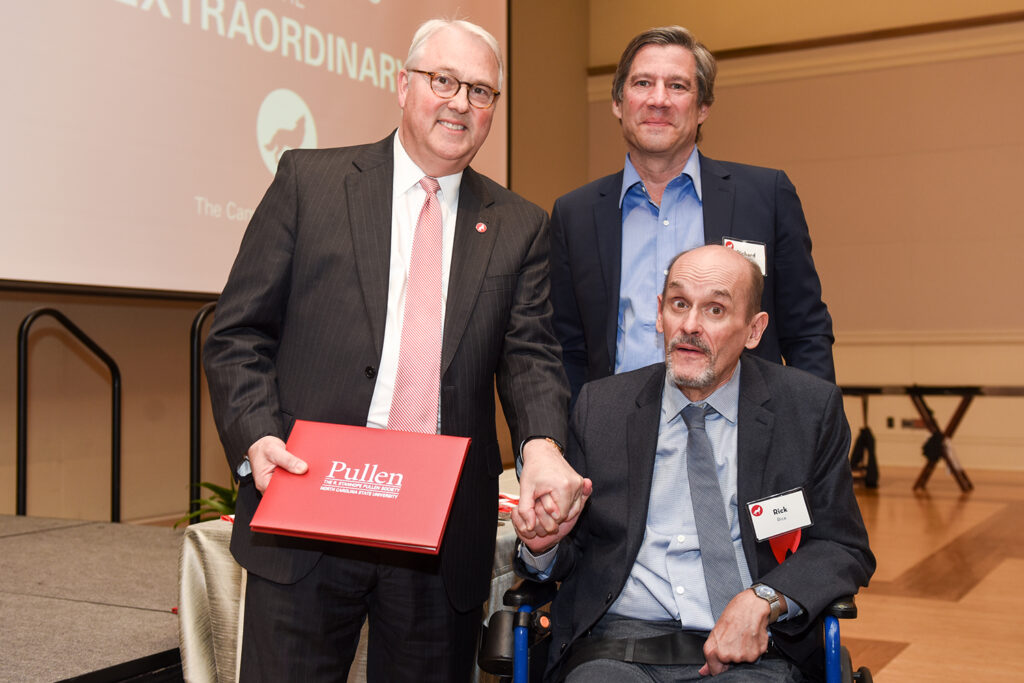Accessible Design Takes Spotlight in Competition

On July 3rd, 2013, Rick Rice was drinking coffee with his partner Richard Gold in the living room of their New York City apartment. Rick’s phone rang, and he answered. It was a medical alert company offering a free device.
“I don’t want one, and I don’t need one,” he responded. He hung up the phone and sat back down on his sofa.
Then, Rick suffered a massive stroke. After three hours of surgery, and three months of rehabilitation, he was left mostly paralyzed on his left side and needed to use a wheelchair for mobility.
It wasn’t his first stroke – the last one he experienced left him with cognitive damage that forced him into retirement from his career in architecture. However, this one changed his and Richard’s life forever.
Once Rick came home from the rehab facility, Richard noticed how difficult it was to help his partner navigate the streets, subways and popular locations of New York.
“After Rick came home from the last rehab facility, I was determined to make our lives as “normal” as possible. I pushed him through the streets and subways of New York City. It was very difficult to maintain.
One night, we were going to the Circle in the Square Theatre. The theater is in a large office building built in the 1970s and has dramatic escalators up to the orchestra and balcony levels. The theater is close to Eighth Avenue, but for a wheelchair to get upstairs we had to go to Seventh Avenue, go to a side door (since we couldn’t use revolving doors) and get the guard’s attention to unlock the door. We then went all the way through the lobby, almost back to Eighth Avenue, to take a service elevator to the second floor to be seated. This was not uncommon.
We entered two-story restaurants in a similar scenario and entered where the baby high chairs, extra chairs, etc. are stored when not in use. We seldom went to an event where I didn’t arrive angry, exhausted and soaking wet from all of the additional effort required to navigate our city.”
– Richard W. Gold
Power, Not Pity
Frustrated and determined, Gold set out to create an alternate solution beyond the too-common access points requiring wheelchair users to enter locations by dumpsters and service areas.

“If architects wish to continue to build buildings with five to fifty steps, like the U.S. Capital in Washington, D.C. – or post offices in most towns and cities – then I want to see a ramp cleverly incorporated into those steps,” says Gold.
Judy Heumann, who was instrumental in laying the foundation for the Americans with Disabilities Act of 1990 was quoted as saying, “I want power, not pity.”
Gold often thinks back to this saying when discussing how architects approach disability. To him, our focus should not be on the suffering caused to those with disabilities by their disabled bodies, but rather on the suffering caused by a society that refuses to include those who are disabled.
Rick Rice, who graduated from the College of Design with a Bachelor of Architecture, was determined to create a scholarship award at the College of Design to set an educational foundation for egalitarian architecture.
Universal Design at NC State
The concept of Universal Design was originally coined by College of Design alumnus Ronald L. Mace [B.Arch. ’66], and promotes the philosophy that design must serve the needs of people regardless of age, ability or status in life.
Mace, who used a wheelchair as a result of polio, initially started his college career as an industrial designer but later changed his major to architecture after experiencing the inaccessible restrooms, elevators and studio spaces at the then-named School of Design. He ended up relying on others to carry him up and down stairs across campus.
He went on to become a leader in universal, barrier-free and accessible design in North Carolina, which established some of the first accessibility guidelines written into statewide building codes in 1973.
In addition to illustrating those building codes, Mace went on to publish multiple works on the topic, and help revise the American National Standards Institute standards for Accessible and Usable Buildings and Facilities.
After years of advocacy and design work to make buildings more accessible, Mace established the Center for Universal Design (CUD) at the School of Design under a grant from the National Institute on Disability and Rehabilitation Research in 1989. The purpose of the CUD was to apply seven principles of Universal Design to existing and new products and built environments:
- Design must be equitable.
- Design must be flexible.
- Design must be simple and intuitive.
- Design must communicate effectively.
- Design must incorporate tolerance for error.
- Design must be used with low physical effort.
- Design must include appropriate size and space for use.
Although the CUD halted operations in 2008 due to financial challenges, its legacy and philosophy continue across ten design research labs at the college.
Award-Winning Accessibility:
The Richard L. Rice, Jr. and Richard W. Gold Design Award is given to B.Arch. students whose ARC 501 projects display design excellence, with an emphasis on accessibility and Universal Design. As part of the competition, 14 students were tasked with designing a new building on NC State Centennial Campus that would serve the Poole College of Management and the Graduate School.
Top Prize (co-winner) | Jasmeen Kaur – $4,000
Top Prize (co-winner): Dottie Sloan – $4,000
Honorable Mention: Caroline Anderson – $1,300
Thank you to our reviewers:
- Brad Burns – designer at Gensler
- Beth Mitchell, AIA – architect at Gensler and B.Arch. alumna
- Calley Hull – student at Guilford College
- Categories:


